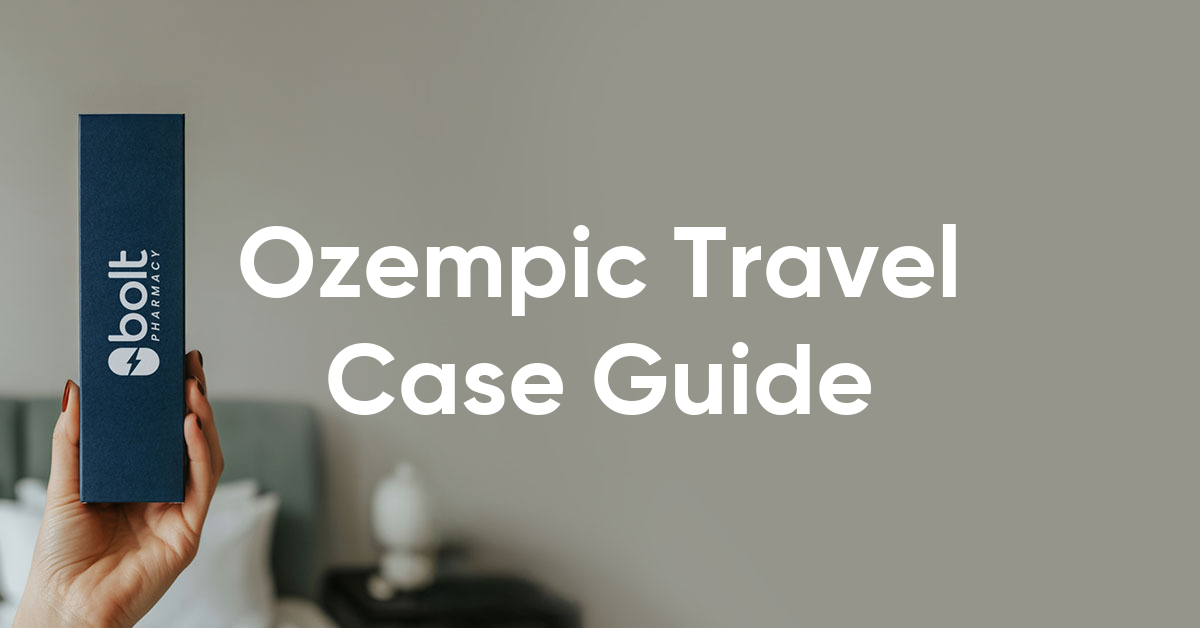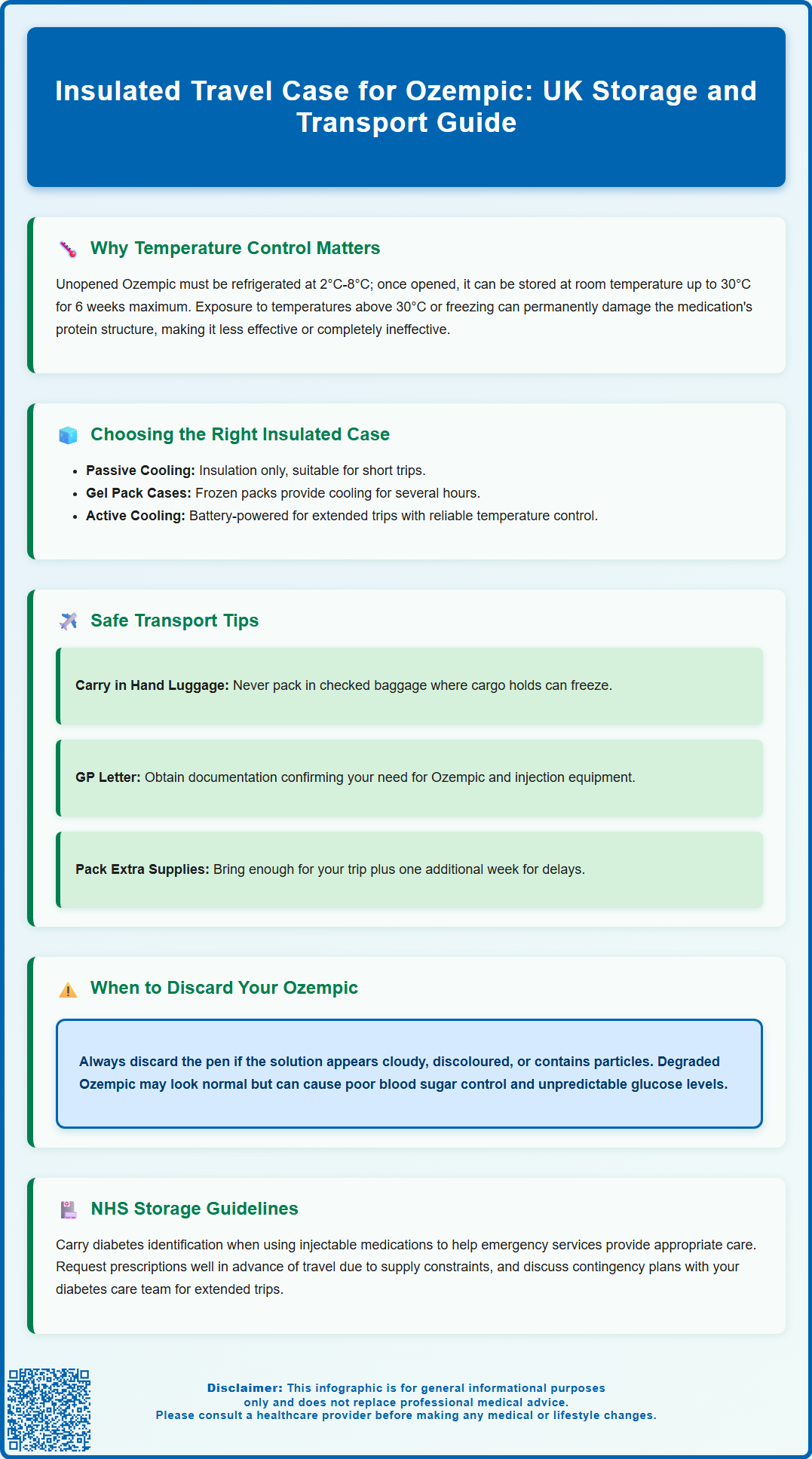Wegovy®
Similar to Ozempic, Wegovy also contains semaglutide but is licensed for weight management. It helps reduce hunger and supports meaningful, long-term fat loss.
- Supports clinically proven weight reduction
- Weekly injection, easy to use

Insulated travel cases for Ozempic provide essential temperature protection for this diabetes medication during journeys. Ozempic (semaglutide), a GLP-1 receptor agonist licensed in the UK for type 2 diabetes, requires strict storage between 2°C and 8°C when unopened, or below 30°C once in use. Temperature excursions can irreversibly damage the medication's protein structure, compromising efficacy and glycaemic control. For patients who travel frequently, whether for work or leisure, maintaining appropriate storage conditions presents significant challenges. Purpose-designed insulated cases create a temperature-controlled environment that protects Ozempic from ambient extremes during air travel, car journeys, and extended periods away from refrigeration, ensuring medication integrity and therapeutic effectiveness.
Summary: Insulated travel cases for Ozempic maintain the required storage temperature (2-8°C unopened, below 30°C in-use) during travel, preventing medication degradation and ensuring therapeutic efficacy.
Ozempic (semaglutide) is a glucagon-like peptide-1 (GLP-1) receptor agonist licensed in the UK for the treatment of type 2 diabetes mellitus. As a biological medication, Ozempic is particularly sensitive to temperature fluctuations, which can compromise its therapeutic efficacy and safety profile.
Storage requirements and stability: According to the Summary of Product Characteristics (SmPC) approved by the Medicines and Healthcare products Regulatory Agency (MHRA), unopened Ozempic pens must be stored in a refrigerator between 2°C and 8°C. Once in use, the pen may be stored at room temperature (not exceeding 30°C) for up to 6 weeks, or it may continue to be refrigerated. The pen cap should always be kept on when not in use to protect from light. Exposure to temperatures outside the recommended range—particularly freezing or excessive heat—can denature the semaglutide protein, rendering the medication less effective or potentially ineffective.
Consequences of improper storage: When Ozempic is exposed to temperatures above 30°C or allowed to freeze, the molecular structure of semaglutide may be irreversibly altered. This degradation is not always visible to the naked eye, meaning patients may unknowingly inject compromised medication. The primary risk is reduced efficacy leading to suboptimal glycaemic control and potential hyperglycaemia. For patients who use Ozempic alongside insulin or sulfonylureas, there may also be an increased risk of unpredictable blood glucose levels. The solution should always be clear and colourless; if it appears cloudy, discoloured or contains particles, the pen should be discarded.
The role of insulated cases: For individuals who travel frequently—whether for work, leisure, or medical appointments—maintaining appropriate storage conditions presents a significant challenge. Insulated travel cases designed for injectable medications provide a practical solution by creating a temperature-controlled microenvironment that protects Ozempic from ambient temperature extremes, particularly during air travel, car journeys in warm weather, or extended periods away from refrigeration.

Selecting an appropriate insulated travel case requires careful consideration of several factors to ensure your Ozempic pen remains within the recommended temperature range throughout your journey. Not all cooling cases are created equal, and understanding the key features will help you make an informed choice.
Types of insulated cases available:
Passive cooling cases: These rely on insulation materials alone, without active cooling elements. They are lightweight and require no power source but typically offer more limited temperature control duration, depending on ambient temperature and insulation quality.
Gel pack cases: These include reusable cooling gel packs that are pre-frozen or refrigerated. They can provide moderate temperature control for several hours, with duration varying by manufacturer and environmental conditions. These are suitable for day trips or shorter journeys.
Active cooling cases: Battery-powered or USB-rechargeable cases that actively maintain a set temperature range. These generally offer more reliable protection for extended travel but are bulkier and more expensive.
Essential features to consider:
When evaluating insulated cases, look for products with manufacturer-verified temperature control capabilities. For unopened pens, cases should maintain temperatures between 2°C and 8°C, while in-use pens can be kept at temperatures up to 30°C. The case should be appropriately sized to accommodate your specific Ozempic pen (0.25mg/0.5mg, 1mg, or 2mg variants) along with any spare needles. Durability is crucial—opt for cases with hard-shell exteriors if you anticipate rough handling during travel.
Temperature monitoring capabilities are increasingly available, with some premium cases featuring built-in digital thermometers or smartphone connectivity to alert you if temperatures drift outside safe parameters. This feature provides valuable reassurance, particularly during long-haul travel or in extreme climates.
Important safety tip: Avoid placing Ozempic pens in direct contact with frozen gel packs, as this may cause the medication to freeze and become unusable.
Regulatory considerations: Many insulated cases are consumer products rather than medical devices. If purchasing a case marketed specifically as a medical device, products in Great Britain may carry either the UKCA mark or, during the transitional period, the CE mark. However, the performance claims of any case should be verified through manufacturer data or independent testing.
Transporting Ozempic safely requires advance planning and awareness of the specific challenges posed by different modes of travel. Whether travelling domestically within the UK or internationally, following evidence-based practices will help ensure your medication remains effective and your diabetes management uninterrupted.
Pre-travel preparation:
Before departure, obtain a letter from your GP or diabetes specialist nurse confirming your need to carry Ozempic and associated injection equipment. This documentation should include your name, the medication name (both brand and generic), dosage, and a statement that the medication requires temperature control. Such letters are particularly important for air travel and when crossing international borders. Request sufficient supplies to cover your entire trip plus an additional week's worth in case of travel delays—NICE guidance (NG28) on diabetes management emphasises the importance of medication continuity.
Always carry your medication in its original packaging with pharmacy labels intact. If travelling with a companion, consider splitting supplies across different bags as a precaution against loss or theft.
Air travel considerations:
Ozempic and its insulated case should always be carried in your hand luggage, never checked baggage, as cargo holds can experience freezing temperatures. According to UK Government and Civil Aviation Authority guidance, passengers may carry medical cooling packs through security checkpoints, but you must declare them to security officers and be prepared to provide evidence they are for medical purposes. Requirements may vary between airports and countries, so check specific policies before travel.
During long-haul flights, do not rely on cabin crew storing your medication in the aircraft galley refrigerator, as this service cannot be guaranteed and risks temperature excursions or loss. Instead, ensure your insulated case has sufficient cooling capacity for the entire journey duration.
Road and rail travel:
When travelling by car during warm weather, never leave your Ozempic in the vehicle, even briefly, as interior temperatures can rapidly exceed 30°C. Keep your insulated case in the passenger compartment rather than the boot, and avoid placing it in direct sunlight. For extended road trips, consider planning rest stops at locations with refrigeration facilities (hotels, restaurants, or pharmacies) where you can refresh cooling packs if necessary.
Destination storage:
Upon arrival at your accommodation, immediately transfer unopened Ozempic pens to a refrigerator. If refrigeration is unavailable, an in-use pen may be kept at room temperature (below 30°C) for up to 6 weeks, but monitor ambient temperatures carefully, particularly in warm climates or during summer months. Some travellers find it helpful to request a room with a minibar refrigerator when booking hotels.
The NHS provides guidance on the safe storage and transportation of diabetes medications, including injectable therapies like Ozempic. These recommendations align with NICE clinical guidelines and MHRA regulatory requirements, forming the foundation of safe medication management for people with diabetes.
Core NHS storage recommendations:
The NHS advises that all unopened GLP-1 receptor agonists, including Ozempic, must be stored in a refrigerator at 2°C to 8°C until first use. Once opened, the pen may be stored at room temperature (not exceeding 30°C) or continued refrigeration for up to 6 weeks, depending on patient preference and environmental conditions. The medication should never be frozen, and if freezing occurs, the pen must be discarded even if subsequently thawed. NHS guidance emphasises checking the expiry date before each injection and disposing of pens 6 weeks after first use, regardless of remaining medication.
Carrying medications in public:
NHS and Diabetes UK advice encourages people with diabetes to carry identification indicating their condition and current medications. This is particularly important for those using injectable therapies, as it assists emergency services in providing appropriate care if the patient becomes unwell. Diabetes UK offers medical ID cards and jewellery that can be invaluable in emergency situations.
When carrying Ozempic outside the home, using an insulated case during warm weather or when refrigeration will be unavailable for extended periods is advisable. The medication should be protected from direct sunlight and extreme temperatures at all times.
Prescription and supply considerations:
NHS patients should request prescriptions well in advance of travel, as GLP-1 receptor agonists including Ozempic have experienced supply constraints, as noted in NHS England Medicine Supply Notifications. If travelling abroad, be aware that semaglutide is available in different formulations: Ozempic (injectable, for type 2 diabetes), Wegovy (injectable, for weight management), and Rybelsus (oral tablets). These are not interchangeable, and formulations may vary between countries. The NHS advises against purchasing diabetes medications abroad without proper medical supervision, as counterfeit products pose significant safety risks.
When to seek advice:
Patients should contact their GP, diabetes specialist nurse, or pharmacist if they have any concerns about medication storage, particularly if they suspect their Ozempic has been exposed to inappropriate temperatures. Signs that medication may have degraded include unusual cloudiness, discolouration, or visible particles—Ozempic should always be clear and colourless. If there is any doubt about medication integrity, it should not be used, and medical advice should be sought promptly.
Diabetes UK recommends that patients travelling for extended periods or to remote locations discuss contingency plans with their diabetes care team, including what to do if medication is lost, stolen, or damaged during travel. Having a clear action plan ensures continuity of care and reduces the risk of diabetes-related complications whilst away from home.
Yes, Ozempic should always be carried in hand luggage with an insulated case, never in checked baggage where cargo hold temperatures can cause freezing. Declare medical cooling packs at security and carry a GP letter confirming your need for the medication.
Once in use, Ozempic can be stored at room temperature below 30°C for up to 6 weeks. The duration your insulated case maintains safe temperatures depends on the case type, ambient conditions, and cooling method used—gel pack cases typically provide several hours of protection.
Contact your GP, diabetes specialist nurse, or pharmacist immediately for advice. Do not use the medication if it appears cloudy, discoloured, or contains particles, as temperature exposure may have compromised its efficacy even if no visible changes are apparent.
The health-related content published on this site is based on credible scientific sources and is periodically reviewed to ensure accuracy and relevance. Although we aim to reflect the most current medical knowledge, the material is meant for general education and awareness only.
The information on this site is not a substitute for professional medical advice. For any health concerns, please speak with a qualified medical professional. By using this information, you acknowledge responsibility for any decisions made and understand we are not liable for any consequences that may result.
Lorem ipsum dolor sit amet, consectetur adipiscing elit, sed do eiusmod tempor incididunt ut labore et dolore magna aliqua. Ut enim ad minim veniam, quis nostrud exercitation ullamco laboris nisi ut aliquip ex ea commodo consequat. Duis aute irure dolor in reprehenderit in voluptate velit esse cillum dolore eu fugiat nulla pariatur.
Block quote
Ordered list
Unordered list
Bold text
Emphasis
Superscript
Subscript